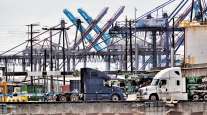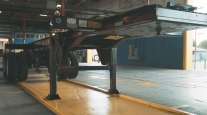Senior Reporter
NACPC Gets Approval to Run Chassis Pool at Georgia, South Carolina Ports

Chassis pool operations at ports in Georgia and South Carolina will shift later this year to a new entity created by the North American Chassis Pool Cooperative, and equipment at the facilities will be expanded and undergo a series of improvements, the group said.
The Federal Maritime Commission on Aug. 2 gave final approval to the Georgia Ports Authority and the South Carolina Ports Authority to shift pool operations to a new entity created by NACPC called the Southern States Chassis Pool.

“Both South Carolina and Georgia are pleased to be moving forward with the proposed SSCP agreement in an effort to add chassis to the current pool,” the two ports said in a statement provided to Transport Topics. “GPA and SCPA hope to not only increase the number of chassis in the Southeast fleet, but improve the quality and provide an at-cost model to support the growth in containerized trade in the Southeast.”
While NACPC will own and operate the new entity, equipment and personnel from the ports’ previous chassis provider, Consolidated Chassis Management, will remain in place, said Dave Manning, president of Nashville, Tenn.-based transportation company TCW and chairman of NACPC. Manning also is chairman of American Trucking Associations.
“We will be contracting with CCM to manage the new pool…instead of CCM owning the pool,” Manning told TT. NACPC is a chassis pool cooperative founded in 2012 by TCW and 10 other trucking companies. A chassis pool consists of a group of third-party owned chassis domiciled at a facility and available to shipping lines and truckers for short-term rental.

Manning
Seafaring ports in Jacksonville, Fla., Tampa and North Carolina have been invited to join the new pool, NACPC said.
It will take more than a year to complete the full transition from CCM to NACPC, Manning said. During that time, the group will respond to concerns about chassis shortages in the southeastern United States by expanding the number of available chassis at the facilities from the current 52,000 and complete some upgrades, Manning said.
“There is an 18-month plan for it all to be upgraded to radial tires, LED lights and [anti-lock brakes] plus add the five-to-10,000 new chassis to the fleet,” Manning said.
The switch to radial tires is especially important in these regions, he noted.
“Particularly in the southeast, where you have a lot of overweight loads, with heat and with long distance, bias ply tires just do not hold up. They fail,” Manning said. “You got drivers who think they’re going to spend 10 hours on a trip and they wind up spending 14, because they spent four hours on the side of the road, waiting for a bias ply tire.”
The port authorities in Georgia and South Carolina said they are responding to the demands of drivers who want better equipment.

Containers at the Port of Charleston, S.C. (Ariana Lindquist/Bloomberg News)
NACPC said the additional chassis will dramatically improve availability of equipment at the ports and reduce the spot shortages that take place during peak periods. The goal is to reduce to 65% from 85% the number of chassis that are in service at any one time, Manning said. By doing that, NACPC said it should always have enough chassis on hand and be able to also cover maintenance and other issues.
While NACPC has not yet set its chassis rental fee, others it operates typically charge $14 to $15 dollars a day. Truckers will pay a single rate, and the service will be provided with at-cost pricing with no profits distributed to NACPC’s owners, Manning said.
NACPC said response from the trucking industry has been positive, but some marine carriers have expressed apprehension since their costs will likely increase. “For the market it’s a good thing, but if you’re a steamship line paying at below cost today, at cost doesn’t sound too good,” Manning said. “The truckers and business capacity owners will be paying less and the marine carriers will be paying a little more than they have in the past, but still, as a whole it’s an at-cost price — which is hard to argue against.”




